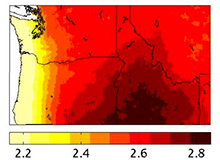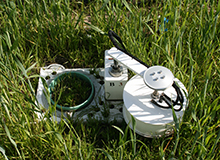
REACCH strives to understand how climate factors and agricultural management practices affect one another in order to reduce agriculture’s negative impacts on climate, while preparing growers for climate-related risks. REACCH teams monitor greenhouse gas (GHG) emissions in the field under different cropping scenarios and simulate climate change impacts on Pacific Northwest agriculture using forecasting models. Field results in combination with simulation models help predict future perturbations associated with agricultural management.
See our products pages for posters and presentations, journal articles, and speed science handouts related to climate. For research highlights and project impacts, explore the links below.

Climate Modeling
Models that integrate climate science with specific agricultural components provide REACCH and our stakeholders with a better understanding of possible changes in economic conditions and conservation policies, as well as the effectiveness of different farming methods under projected changes.
Related articles
Related annual report articles
- Weather, climate and agriculture
- End-of-the century climate and Pacific Northwest wheat production
- Is regional warming natural or not?
- Asymmetric warming projections for the inland Pacific Northwest
- Climate change and agriculture: Model projections
- Why hasn’t spring warmed?
- Climate change loads the dice for hot summers
- Mountain snow and inland Pacific Northwest agriculture

Greenhouse Gas (GHG) Monitoring
Carbon dioxide (CO2) and nitrous oxide (N2O) are the primary GHG concerns associated with cereal systems. Emissions can largely be managed using conservation crop and soil management strategies.
Related articles
Related annual report articles
- Nitrous oxide in the inland Pacific Northwest
- Seasonal dynamics of N2O and CO2 emissions
- Nitrification and denitrification pools of N2O: Acetylene inhibition study
- N2O and CO2 production in wheat-based cropping systems
- Catching carbon on the Palouse
- Nitrous oxide emissions protocols for the Pacific Northwest
- Carbon credits for tilled and no-tilled winter wheat
The following table summarizes the main impacts of climate change in the Pacific Northwest.
| Climate Trend | Observed Change† | Projected Change‡ | Impacts |
| Warmer Winters | +1.3F | +5.2F | Reduced snowpack, increased winter runoff, reduced overwinter mortality |
| Warmer Springs | +1.3F | +5F | Earlier greenup and plant maturation, longer freeze free season |
| Warmer Summers | +1.2F | +6F | Increased heat stress and evapotranspiration |
| Wetter Springs | +12% | +5% | Offset increased water use by plants, increased potential for water logged soils |
| Drier Summers | -3% | -9% | Increased drought stress |
† 1985-2014 versus 1895-1984
‡ 2040-2069 versus 1971-2000
Obs change is from NCDC data using an average of WA/OR/ID
Projected change are from MACA RCP8.5 data and represent the multi-model mean change for the NW US covering WA/OR/ID and western MT.

